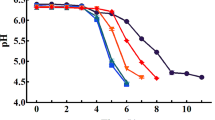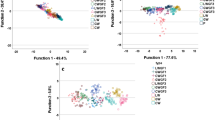Abstract
The effects of Spirulina platensis and Dunaliella salina biomass (1% and 2%) on formulated cookies were studied. Colour, hardness, moisture content, ash content, protein content, lipid content, total phenolic content and total antioxidant activity by CUPRAC were assessed, and a sensory evaluation of the cookies was performed. The results show that the cookies baked with added Spirulina were significantly harder and darker than the controls, and the Dunaliella addition did not affect the protein content as much as the Spirulina addition, but the effect on moisture content was significantly positive. Additionally, higher total phenolic content and CUPRAC values were found for the Dunaliella-enriched cookies. After the sensory evaluation, the Dunaliella-enriched cookies were more acceptable to consumers.



Similar content being viewed by others
References
AACCI (1990) Approved methods of american association of cereal chemists international (AACCI), St. Paul
Achour Y (2014) Evaluation of nutritional and sensory properties of bread enriched with Spirulina. Annals 15:270–275
Agustini T, Farid Ma’ruf W, Widayat W, Suzery M, Hadiyanto H, Benjakul S (2016) Application of Spirulina platensis on ice cream and soft cheese with respect to their nutritional and sensory perspectives. J Teknol 78:245–251
AOAC (1990) Official methods of analysis of association of official analytical chemists (AOAC), Washington, DC
Apak R, Güçlü K, Özyürek M, Karademir SE (2004) Novel total antioxidant capacity index for dietary polyphenols and vitamins C and E, using their cupric ion reducing capability in the presence of neocuproine: CUPRAC method. J Agric Food Chem 52:7970–7981
Barkallah M, Dammak M, Louati I, Hentati F, Hadrich B, Mechichi T, Ayadi MA, Fendri I, Attia H, Abdelkafi S (2017) Effect of Spirulina platensis fortification on physicochemical, textural, antioxidant and sensory properties of yogurt during fermentation and storage. LWT 84:323–330
Barkia I, Saari N, Manning SR (2019) Microalgae for high-value products towards human health and nutrition. Mar Drugs 17:304–332
Batista AP, Niccolai A, Fradinho P, Fragoso S, Bursic I, Rodolfi L, Biondi N, Tredici MR, Sousa I, Raymundo A (2017) Microalgae biomass as an alternative ingredient in cookies: sensory, physical and chemical properties, antioxidant activity and in vitro digestibility. Algal Res 26:161–171
Bishop WM, Zubeck HM (2012) Evaluation of microalgae for use as nutraceuticals and nutritional supplements. J Nutr Food Sci 2(5):147–152
Bolanho BC, Egea MB, Jácome ALM, Campos I (2014) Antioxidant and nutritional potential of cookies enriched with Spirulina platensis and sources of fibre. J Food Nutr Res 53(2):171–179
Borowitzka MA, Siva CJ (2007) The taxonomy of the genus Dunaliella (Chlorophyta, Dunaliellales) with emphasis on the marine and halophilic species. J Appl Phycol 19:567–590
Çiftçi S (2018) Production of reduced-fat cookies. Uludag University Graduate School of Natural and Applied Science Department of Food Engineering. MSc thesis, Bursa, p 61
de Morais MG, Vaz BS, Morais EG, Costa JAV (2015) Biologically active metabolites synthesized by microalgae. Biomed Res Int 2015:1–15
El-Baki HHA, El-Baz F, El Baroty G (2009) Production of phenolic compounds from Spirulina maxima microalgae and its protective effects. Afr J Biotechnol 8:7059–7067
El-Baz FK, Abdo SM, Hussein AMS (2017) Microalgae Dunaliella salina for use as food supplement to improve pasta quality. Int J Pharm Sci Rev Res 46(2):45–51
Figueira FS, Crizel TM, Silva CR, Salas-Mellado MM (2011) Elaboration of gluten-free bread enriched with the microalgae Spirulina platensis. Braz J Food Technol 14(4):308–316
Fradique M, Batista AP, Nunes MC, Gouveia L, Bandarra NM, Raymundo A (2013) Isochrysis galbana and Diacronema vlkianum biomass incorporation in pasta products as PUFA’s source. LWT Food Sci. Technol 50:312–319
García-Segovia P, Pagán-Moreno MJ, Lara IF, Martínez-Monzó J (2017) Effect of microalgae incorporation on physicochemical and textural properties in wheat bread formulation. Food Sci Technol Int 23:437–447
Gouveia L, Batista AP, Miranda A, Empis J, Raymundo A (2007) Chlorella vulgaris biomass used as coloring source in traditional butter cookies. Innov Food Sci Emerg Technol 8:433–436
Gouveia L, Coutinho C, Mendonça E, Batista AP, Sousa I, Bandarra NM, Raymundo A (2008) Functional biscuits with PUFA-ω3 from Isochrysis galbana. J Sci Food Agric 88:891–896
Khan MI, Shin JH, Kim JD (2018) The promising future of microalgae: current status, challenges, and optimization of a sustainable and renewable industry for biofuels, feed, and other products. Microb Cell Fact 17:36–57
Lucas BF, Morais MG, Santos TD, Costa JAV (2017) Effect of Spirulina addition on the physicochemical and structural properties of extruded snacks. Food Sci Technol 37:16–23
Lucas BF, Morais MG, Santos TD, Costa JAV (2018) Spirulina for snack enrichment: nutritional, physical and sensory evaluations. LWT 90:270–276
Machu L, Misurcova L, Vavra Ambrozova J, Orsavova J, Mlcek J, Sochor J, Jurikova T (2015) Phenolic content and antioxidant capacity in algal food products. Molecules 20:1118–1133
Malik P, Kempanna C, Paul A (2013) Quality characteristics of ice cream enriched with Spirulina powder. IJFANS 2(1):44–50
Marcinkowska-Lesiak M, Onopiuk A, Zalewska M, Ciepłoch A, Barotti L (2018) The effect of different level of Spirulina powder on the chosen quality parameters of shortbread biscuits. J Food Process Pres 42:13561
Mazinani S, Fadaei V, Khosravi-Darani K (2016) Impact of Spirulina platensis on physicochemical properties and viability of Lactobacillus acidophilus of probiotic UF feta cheese: microalgal incorporation probiotic UF feta cheese. J Food Process Pres 40:1318–1324
Menezes BS, Coelho M, Meza S, Salas-Mellado M, Souza MRAZ (2015) Macroalgal biomass as an additional ingredient of bread. Int Food Res J 22:812–817
Prabhasankar P, Ganesan P, Bhaskar N (2009) Influence of indian brown seaweed (Sargassum marginatum) as an ingredient on quality, biofunctional, and microstructure characteristics of pasta. Food Sci Technol Int 15:471–479
Rodríguez De Marco E, Steffolani ME, Martínez CS, León AE (2014) Effects of spirulina biomass on the technological and nutritional quality of bread wheat pasta. LWT 58:102–108
Różyło R, Hameed Hassoon W, Gawlik-Dziki U, Siastała M, Dziki D (2017) Study on the physical and antioxidant properties of gluten-free bread with brown algae. CyTA J Food 15:196–203
Şahin OI (2019) Effect of Spirulina biomass fortification for biscuits and chocolates. TURJAF 7:583–587
Shalaby S, Nabih N (2013) Quality characteristics of croissant stuffed with imitation processed cheese containing microalgae Chlorella vulgaris biomass. World J Dairy Food Sci 8:58–66
Tang G, Suter PM (2011) Vitamin A, nutrition, and health values of algae: spirulina, chlorella, and dunaliella. J Pharm Nutr Sci 1:111–118
Tibbetts SM, Milley JE, Lall SP (2015) Chemical composition and nutritional properties of freshwater and marine microalgal biomass cultured in photobioreactors. J Appl Phycol 27:1109–1119
Author information
Authors and Affiliations
Corresponding author
Additional information
Publisher's Note
Springer Nature remains neutral with regard to jurisdictional claims in published maps and institutional affiliations.
Rights and permissions
About this article
Cite this article
Şahin, O.I. Functional and sensorial properties of cookies enriched with SPIRULINA and DUNALIELLA biomass. J Food Sci Technol 57, 3639–3646 (2020). https://doi.org/10.1007/s13197-020-04396-4
Revised:
Accepted:
Published:
Issue Date:
DOI: https://doi.org/10.1007/s13197-020-04396-4




